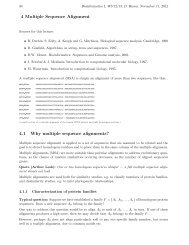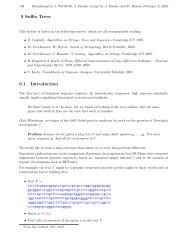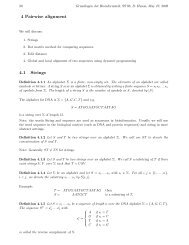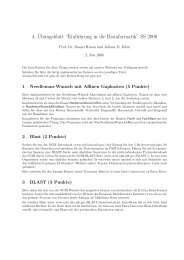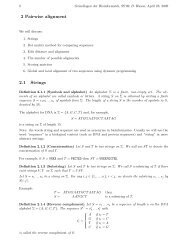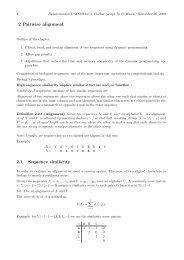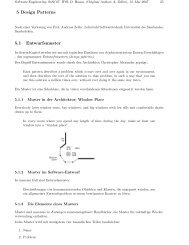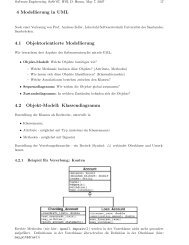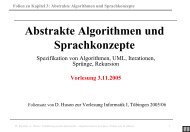4 Multiple Sequence Alignment 4.1 Multiple sequence alignment
4 Multiple Sequence Alignment 4.1 Multiple sequence alignment
4 Multiple Sequence Alignment 4.1 Multiple sequence alignment
You also want an ePaper? Increase the reach of your titles
YUMPU automatically turns print PDFs into web optimized ePapers that Google loves.
Grundlagen der Bioinformatik, SS’09, D. Huson, May 10, 2009 35Definition 4.2.1 (MSA) A multiple <strong>sequence</strong> <strong>alignment</strong> (MSA) of A is obtained by inserting gaps(’-’) into the original <strong>sequence</strong>s such that all resulting <strong>sequence</strong>s A ∗ i have equal length L ≥ max{n i |i = 1, . . . , r}, A ∗ i = A i after removal of all gaps from A ∗ i , and no column consists of gaps only.Example:A = {apple, paper, pepper}⎧⎫⎨ - a p p l e - ⎬A∗ = p a p - - e r⎩⎭p e p p - e r⎧⎪⎨A ∗ :=⎪⎩A ∗ 1 = (a ∗ 11, a ∗ 12, . . . , a ∗ 1L )A ∗ 2 = (a ∗ 21, a ∗ 22, . . . , a ∗ 2L ).A ∗ r = (a ∗ r1, a ∗ r2, . . . , a ∗ rL ),4.3 Scoring an MSAIn the case of a linear gap penalty, if we assume independence of the different columns of an MSA,then the score α(A ∗ ) of an MSA A ∗ can be defined as a sum of column scores:α(A ∗ ) :=L∑s(a ∗ 1i, a ∗ 2i, . . . , a ∗ ri).i=1Here we assume that s(a ∗ 1i , a∗ 2i , . . . , a∗ ri ) is a function that returns a score for every combination of rsymbols (including the gap symbol).For pairwise <strong>alignment</strong>s there are three types of columns, a match, or a blank in either of the two<strong>sequence</strong>s. The following table shows the 7 possibilities for three <strong>sequence</strong>s:a 1i − a 1i a 1i − − a 1ia 2j a 2j − a 2j − a 2j −a 3k a 3k a 3k − a 3k − −For r <strong>sequence</strong>s, the number of different column types iswhere i is the number of gaps.∑r−1( r= 2i)r − 1i=04.3.1 The sum-of-pairs (SP) scoreHow to define the score s? For two protein <strong>sequence</strong>s, s is usually given by a BLOSUM or PAMmatrix. For more than two <strong>sequence</strong>s, providing such a matrix is not practical, as the number ofpossible combinations is too large.Given an MSA A ∗ , consider two <strong>sequence</strong>s A ∗ p and A ∗ q in the <strong>alignment</strong>. For two aligned symbols uand v we define:⎧⎨ match score for u and v, if u and v are residues,s(u, v) :=−dif either u or v is a gap, or⎩0 if both u and v are gaps.




